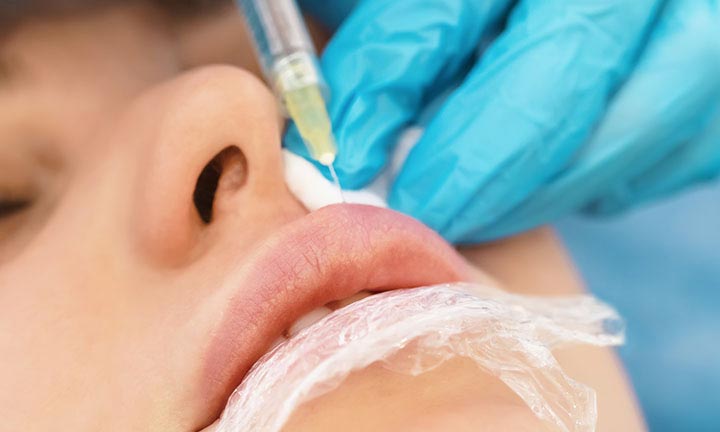Lip augmentation adds volume to thinning lips, creating a more youthful appearance. There are several types of lip augmentation, including lip fillers, implants, fat transfers and lip lifts. Recovery time, results and possible risks vary with each procedure.
Advertisement
Cleveland Clinic is a non-profit academic medical center. Advertising on our site helps support our mission. We do not endorse non-Cleveland Clinic products or services. Policy

Lip augmentation is an in-office cosmetic procedure that creates fuller, more youthful-looking lips. There are different types of lip augmentation to fit your needs and goals. Some procedures are nonsurgical, using fillers to plump up the lips temporarily. Others involve small incisions in your lips or face for longer-lasting results.
Advertisement
Cleveland Clinic is a non-profit academic medical center. Advertising on our site helps support our mission. We do not endorse non-Cleveland Clinic products or services. Policy
Types of lip augmentation include:
Healthcare providers mainly use lip fillers that contain hyaluronic acid, a natural substance found in your body. Common hyaluronic acid fillers include Restylane® and Juvéderm®. Some fillers also contain lidocaine, which numbs your skin to prevent pain or discomfort from the procedure.
How long your fuller lips last varies by procedure. For example:
The best lip augmentation procedure is different for every person. The right procedure for you depends on your goals and lip shape and size. For example, lip implants or a lip lift may be ideal if you prefer permanent results.
Advertisement
However, implants may not be appropriate for razor-thin or asymmetrical lips. Together with your healthcare provider, you can determine the best approach for you.
Your plastic surgeon will help you decide whether you’re a good candidate for lip augmentation and which procedure is right for you.
In most cases, you’re a candidate for lip augmentation if you:
Your healthcare provider will give you specific instructions on how best to prepare. A few weeks before the procedure, you’ll need to stop smoking and taking blood-thinning medication, which can worsen bruising. Avoid pain relievers like aspirin and herbal supplements like multivitamins and fish oil.
Your plastic surgeon will likely use local anesthesia to numb the area so that you don’t feel any pain. You’ll be awake for the procedure. If you’re having multiple cosmetic surgeries, you may receive general anesthesia and be asleep the entire time.
Here’s what to expect according to the type of lip augmentation procedure you have:
When getting lip injections, your healthcare provider uses a fine needle to inject the filler into your lips. The injections typically take 10 to 30 minutes.
If the injected substance contains fat from your body, you’ll have liposuction to remove the fat, usually from your belly area. After the fat is purified, your plastic surgeon injects it into your lips. The entire procedure takes about 60 to 90 minutes to complete.
This procedure usually lasts about 30 minutes. During lip implant surgery, your plastic surgeon:
This procedure typically takes about an hour. During a lip lift, your plastic surgeon:
In another type of lip lift, the surgeon makes two small incisions on each side of your mouth and removes a bit of skin from those areas.
You’ll receive instructions for helping your lips heal and optimizing your results. The plastic surgeon may suggest:
Advertisement
Lip augmentation gives your lips a fuller, younger look. Depending on which procedure you have, lip augmentation has minimal to no downtime.
Results with some lip augmentation procedures are reversible. If you’re unhappy with the outcome of lip implant surgery, your plastic surgeon can remove the implant. If you have lip fillers, your healthcare provider can dissolve them with hyaluronidase, an enzyme that breaks down hyaluronic acid.
Talk to your plastic surgeon about potential issues after lip augmentation. Your chances for risks and complications go up with surgical lip augmentation. But nonsurgical lip augmentation also has risks.
In general, possible risks and complications include:
Recovery time differs depending on the type of lip augmentation you have. With lip fillers, there’s little to no recovery time. With surgical lip augmentation, you may need a few days to several weeks for bruising, redness and swelling to subside.
Advertisement
With nonsurgical lip augmentation, you can typically return to work right away. Surgical lip augmentation may require some downtime. With any lip augmentation procedure, your plastic surgeon may suggest avoiding exercise and other strenuous activities for up to several weeks.
Call your plastic surgeon right away if you develop:
Lip augmentation uses different nonsurgical and surgical techniques. For a fuller look, your plastic surgeon may inject fillers with hyaluronic acid or your own fat into your lips. Or you may opt for a lip implant or lip lift to permanently plump up your lips. Your plastic surgeon will help you decide which lip augmentation procedure is right for your lips and goals.
Advertisement
Whether you need cosmetic or reconstructive plastic surgery, you’ll need skilled, detailed and compassionate providers. At Cleveland Clinic, we’re here to help.

Last reviewed on 04/14/2022.
Learn more about the Health Library and our editorial process.